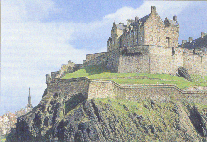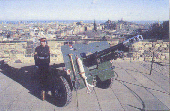 Edinburgh Castle
Edinburgh Castle Edinburgh Castle
Edinburgh Castle
THE castle is Edinburgh's best known and most popular visitor
attraction. It is, therefore, a good idea (particularly if your stay
in Edinburgh has to be brief) to visit the castle first.
For one thing, the magnificent panorama from the battlements will give
you a splendid idea of the city and the surrounding terrain. It will
be immediately apparent to history buffs, for example, why Edinburgh
Castle was of strategic importance during Scotland's wars of
independence.
Long before that, however, the precipitous rock, rising out of
surrounding forest, is known to have been a tribal refuge and
settlement. There is archaeological evidence of human habitation on
the crag in the Bronze Age, about 1,000 BC. This evidence makes
Edinburgh one of the longest continuously inhabited places in northern
Europe.

Edinburgh Castle
Where did Edinburgh get its name? The answer is obscured by the mists
of time. The name could be a corruption of Edwin's Burgh,
commemorating a ninth-century king of Northumbria, whose realm
extended to the Firth of Forth. Other authorities, however, suggest
that the original form of the city's name was `din Eidyn'
this is Brythonic, a language akin to Welsh, spoken in the
south-east of Scotland at the time.
Whatever doubts there may be about the name, the Castle Rock is
undeniably where Edinburgh began. Early Edinburgh was a small
settlement on the eastern side of the fortified rock, huddled close to
the crag for protection. In the valley was a stretch of water, the
Nor' Loch, which was developed in the fifteenth century as part of
the town's defences. Three hundred years later, however, with the
advent of more peaceful times, the loch was drained to make way for
Princes Street Gardens.
Through the centuries, the castle was besieged many times, badly
knocked about, held by the English as well as by the Scots, and
well-nigh demolished more than once. But it always rose again. In that
sense, the story of the castle is the story of Scotland.
Though the castle is a historic monument, it is also a working
military establishment, being the headquarters of the Scottish
Division: that is why there is a guard on the main gate.
One of the most evocative buildings within the castle is also the
smallest and oldest - Saint Margaret's Chapel, built in the
Norman fashion almost 1,000 years ago in honour of the saintly wife of
King Malcolm III. Because of its religious significance, the tiny
chapel survived every military demolition. After 900 years it is
still in use, and members of the castle garrison may exercise their
right to be married within it.
The castle was the seat of Scottish kings, and the royal apartments on
view to the public include a tiny room in which Mary, Queen of Scots
gave birth to the boy who became King James VI of Scotland and James I
of England upon the death of Queen Elizabeth I of England in
1603. Within the royal apartments a permanent exhibition, in the form
of a series of impressive tableaux, depicts some of the milestones in
Scotland's story.
The ancient Honours of Scotland - the crown, sceptre and sword of
state - are on view in the Crown Room. One of the most romantic of the
stories attached to the ancient crown jewels of Scotland concerns the
manner of their rediscovery in 1818. It was known that, at the Treaty
of Union in 1707, when the old Scots Parliament was dissolved for ever
(`the end of an auld sang'), the Scottish Regalia had been deposited
within Edinburgh Castle. No more appropriate resting-place for these
revered relics of Scotland's sovereignty could have been found. As the
years passed, there were disturbing rumours that the ancient regalia
had been quietly removed to London. Eventually, largely by the
intercession of that super-patriot
Today the ancient symbols of sovereignty are on permanent display to
the people in that same room, where they saw the light of day once
more almost two centuries ago. As one gazes upon the gleaming crown,
sceptre and sword of state, it is not difficult to conjure up the
drama of some earlier chapters of that `auld sang'.
Nearby, in the Great Hall, which has an ornate wooden ceiling, there
is an interesting collection of weapons and armour.
Across the square is the Scottish National War Memorial, a building
designed by Sir Robert Lorimer and built shortly after the First World
War. Few who walk round its interior fail to be moved by the
experience. The graphic decoration speaks eloquently of the awful
price that has been paid for our liberty.
On the western side of the square is the Scottish United Services
Museum, which has an additional gallery in Hospital Square.
Near the summit of the castle a small, well-tended plot below the
ramparts has served for many years as a cemetery for the pets of
members of the garrison.

One O'clock Gun
The castle is also the home of the most famous cannon in Scotland: Mons Meg, a massive fifteenth-century bombard, which was reputed to be able to fire a large stone cannonball a distance of one-and-a-half miles. Its devastating effect earned Meg the alternative name, `the Muckle Murderer'. Salutes from the castle these days are fired by more modern artillery, when for example Her Majesty the Queen celebrates her birthday or enters Edinburgh on an official visit. Speaking of artillery, a unique institution within the castle is the One o'Clock Gun, which is fired at that hour every day (except Sunday) to enable citizens and visitors to check their clocks and watches. The origin of the tradition lies in the days when sailing ships in the Firth of Forth were able to check their chronometers by training a telescope on the castle. Simultaneously, a time ball drops at the Nelson Monument on Calton Hill.
For three weeks in August each year the Castle Esplanade is the venue of the world-famous Edinburgh Military Tattoo, when the Scottish regiments host a lively programme of military music, marching and historical re-enactments under floodlights before large and appreciative audiences from all over the world.
Before leaving the esplanade, look for an artistically decorated drinking-well in the wall at the north-east corner. It is a grim reminder of the days when, on this spot, women, usually elderly, were executed by burning after having been convicted of practising witchcraft.
There is a more cheerful relic at Cannonball House, a few yards away at the top of the Castle Wynd steps. The building takes its name from a cannonball, embedded in the wall about halfway up. There are two legends, one military and one civil. The first story, which gunners dismiss as impossible, is that the cannonball was fired from the castle in 1745 and that it was aimed at Holyrood Palace, where Bonnie Prince Charlie was in residence during his march south (Edinburgh's allegiances were divided on this attempt by the Stuarts to regain the British throne).
The second, more prosaic story is that the cannonball was carefully placed here by engineers to mark the precise height above sea-level of the fresh springs at Comiston, in the hills to the south, which provided Edinburgh with its first piped supply of fresh water, in about 1621. Certainly the low building on the north side of the street was until recently a large water tank, serving the Old Town. Now, however, there are plans to use the redundant building for a tourism-related project.



